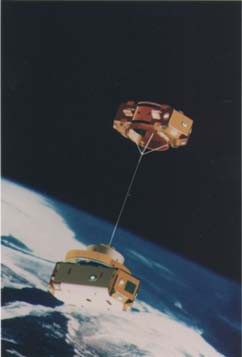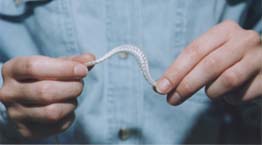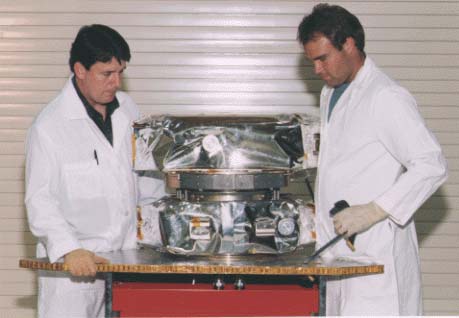25 March 1997
Source:
http://www.nro.odci.gov/prs_rel10.htm

20 November 1996
Purpose: The Tether Physics and Survivability (TiPS) experiment consists
of two small end masses (dubbed "Ralph" and "Norton") connected by a 4 km
tether. TiPS has been designed as a quick reaction, low cost experiment to
research on-orbit tether motion and survivability characteristics. Radar
and optical ground sensors tracking TiPS provide data on long term tether
dynamics to validate existing tether dynamics models. As the longest lasting
tether system to date, TiPS will also provide data on space tethers' long
term survivability. Confidence in these models is necessary to reduce the
risk for future operational tether applications and focused tether
experiments.
TiPS Sponsor: National Reconnaissance Office (NRO). TiPS is the NRO's
first unclassified, on-orbit spacecraft.

TiPS Design and Integration: Naval Research Laboratory (NRL).
Physical Characteristics:
| Weight | Dimensions | |
|---|---|---|
| Ralph | 93 lbs | 27 in x 14 in x 7 in |
| Norton | 22 lbs | 27 in x 14 in x 7 in |
| Tether | 12 lbs | 2-3 mm diameter, 4 km long |
| Total | 127 lbs |
Tether: 4 km Spectra 1000 braid over acrylic yarn.
Attitude Control: Gravity gradient stabilized. No active measures.
Orbit:
Launch and Jettison: TiPS was jettisoned from a host vehicle on June 20, 1996 into a 552 nm, 63.44 deg circular orbit. The TiPS jettison occurred in the positive velocity vector using a separation nut/jettison bolt mechanism and four spring cartridges designed to impart a 3 ft/sec separation velocity.
Tether Deployment: Almost 3 hours after TiPS was jettisoned, the two TiPS endbodies were separated using a bolt cutter, Marman clamp mechanism, and ten spring cartridges designed to impart a 16.5 ft/sec separation velocity. Because of drag in the tether reel, gravity gradient forces were relied upon to fully deploy the 4 km tether. Complete deployment of the tether took 42 minutes and occurred within view of the AF Phillips Laboratory's Starfire Optical Range (SOR) and NASA's laser ranging sites. Deployment halted for 2.5 minutes as libration swung the two end masses close to a horizontal position. When the libration abated and the endmasses returned to a more vertical orientation, gravity gradient forces again dominated and the tether deployment concluded. The tether deployment interruption was expected.

Ralph contains a transmitter and a Small, Expendable Tether Deployer System (SEDS) box provided by NASA. The SEDS box counted the turns of the tether spool as the tether deployed. This information was transmitted to Air Force Space Control Network until the battery ran down, and forwarded to NASA and NRL for further analysis. The transmitter and the SEDS box were powered for several hours by a Lithium-Thionyl Chloride battery. Once the battery died, TiPS became completely passive.
Position Determination: There are 18, one-inch diameter laser retro-reflectors mounted on each end body for use by worldwide Satellite Laser Range (SLR) sites to determine the TiPS inertial position and tether attitude. The laser retro-reflectors mounted on Norton are uncoated while the laser retro-reflectors mounted on Ralph are coated with TiO2 and SiO2. The coatings allow the end bodies to be distinguished since both sets of retro-reflectors will reflect green laser sources (.532 microns) but only the retro-reflectors on Norton will reflect infrared laser sources (1.064 microns). At TiPS altitude of 552 nm, the Space Laser Range allow TiPS' end bodies to be determined to an accuracy of approximately 15 centimeters (1 sigma).
In addition to the Space Laser Range, TiPS is tracked by highly accurate ground based radars. These radars are not limited by illumination constraints currently imposed on the SLR sites. Until the tether model can generate very precise pointing vectors, the SLR sites can only track TiPS when the spacecraft is illuminated by the sun and the laser site is in darkness. This condition is called "terminator" mode. In terminator mode, the brightly illuminated spacecraft can be easily acquired by the laser sites regardless of prediction errors. The principle radar that will augment laser observations is the HAVESTAREX-band radar located at Vanderberg AFB. As more observations are processed, it is hoped that the tether prediction models will generate more accurate pointing predictions.
TiPS is also tracked by the USSPACECOM Space Surveillance Network (SSN). The system tracks each end mass independently, and occasionally returns tracks from a UHF dipole imbedded in the tether at the system's center of mass. Element sets obtained from USSPACECOM form the basis for tether position predictions. Unfortunately, the UHF radars forming the mainstay of the SSN can not provide precise enough observations to accurately model tether dynamics.
Space Laser Range: NASA provides access to the worldwide Space Laser Range consisting of both NASA and international optical ranging facilities. In support of TiPS operations, Allied Signal in Greenbelt, MD generates and distributes the interrange vectors required for these sites to acquire and track the end masses. Allied Signal will also consolidate the data sets collected by the SLR sites, and to make the data available to scientists and the public through the Internet. All data consolidated by Allied Signal will also be passed to NRL for analysis and archiving.
NASA SLR Sites
|
International SLR Sites
|
Other Participating Laser Sites
|

Results to Date: Observed TiPS motion confirm anticipated results. Maximum in-plane libration angle is based upon three events; the rate the tether is extended, the amount of friction realized from the tether spool during release, and the angle relative to the Earth in which the tether is released. A maximum in-plan libration angle of about 40 degrees was expected, which generally agreed with observed value of 30 degrees a week after release. Libration in the plane perpendicular to the plane of motion, called cross-plane libration, was measured at this time to be about 15 degrees.
Two interesting characteristics were observed shortly after tether deployment. First, the tether quickly became bowed. This abnormality was later confirmed by Space Laser Range data which indicated the two end masses were 80 meters closer together than if the tether was straight and rigid. Secondly, the bow appears to be rotating in a "skip rope" manner about an imaginary line connecting both endmasses.
These two characteristics are probably due to the large amount of rotational momentum transferred from the endmasses at deployment. TiPS was deployed from its host spacecraft spinning at 4 revolutions per second. With a combined moment of inertia in the spin axis of approximately 5920lbm*in2, the host vehicle imparted an extra 0.1 foot pound force of rotational energy into the TiPS system.
The spacecraft's overall system energy appears to be dampening with time. Libration has decreased in both in-plane and cross-plane directions. Visual observations taken at the Air Force Maui Optical Site (AMOS) during the last week of September, 1996, show in-plane libration has decreased to about 12 degrees while cross-plane libration has decayed to about 8 degrees. Libration periods have remained relatively stable at about 65 minutes and 56 minutes for in-plane and cross-plane libration periods, respectively. Furthermore, recent observations indicate that the tether bow has decreased significantly. The reduction in vertical length between the two end masses was 80 meters a week after deployment and 15-20 meters after three months. The period of the bow rotation is estimated to be several hours long. Finally, the endmasses appear to be slowing down as well from their initial spin rate of 4 rev/min to about 0.5 rev/min.
| A Week After Deployment | 3 Months From Deployment | |
|---|---|---|
| In-Plane Libration | 30 deg, 65 min period | 12 deg, 64 min period |
| Cross-Plane Libration | 15 deg, 56 min period | 8 deg, 58 min period |
| Bow (reduction in vertical length) | 2% | 0.4% |
| Endmass Rotations | 4 rev/min | 0.5 rev/min |
The tether dampening appears to be caused by several effects. The most important effects are the bending of the tether, the torsional waves, the skip rope effect, and the frictional forces. The continuing small but finite bending of the tether as it rotates around the Earth would release energy causing dampening of the tether especially along the velocity vector. This factor would explain the larger reduction of the in-plane libration. The torsional waves would cause friction between the fibers in the tether, releasing energy, and dampening the system. As the tether's motion follows a skip rope effect, the variation of the gravity gradient and the centrifugal forces of the bow effect would cause the tether to stretch and retract. This hysterisis effect will make the fibers work against each other releasing energy and dampening the system. Finally, there would be some dampening due to frictional forces of the rarefied atmosphere at this altitude, further taking energy out of the TiPS system.
Changes in TiPS orbit characteristics, such as eccentricity, inclination, and altitude, have been typical of equivalently sized non-tethered spacecraft in similar orbits
Internet Address: Spacecraft details and orbit ephemeris are available to both international researchers and the public through the TiPS Internet home page at http://hyperspace.nrl.navy.mil/TiPS.
Any questions should be directed to NRO Public Affairs at (703) 808-1015.

|

|

|

|

|

|

|
